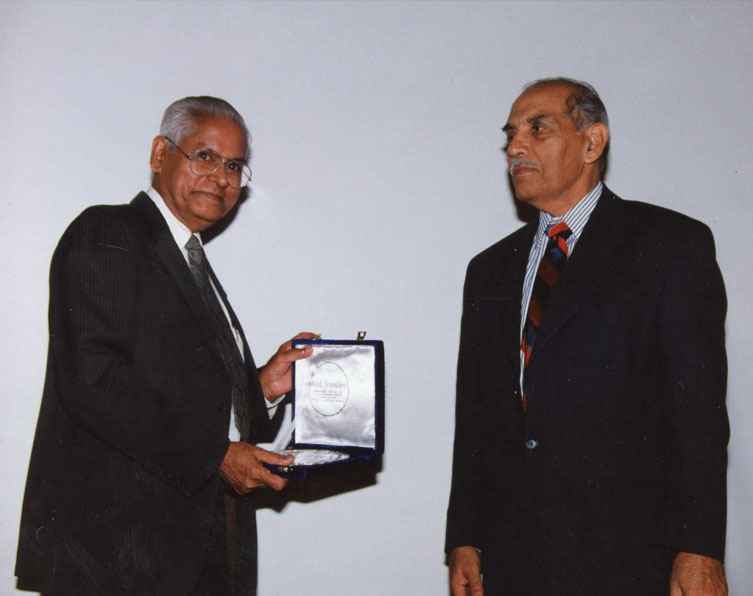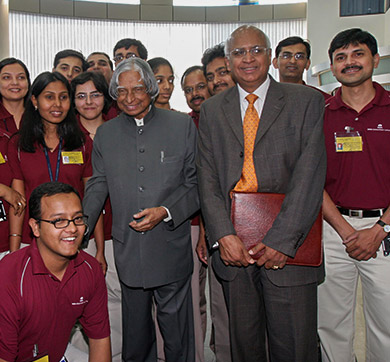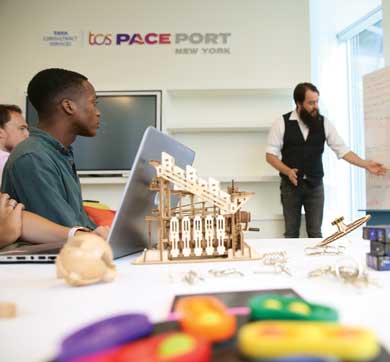July 2021 | 2,494 words | 9-minute read
In 1973, the first global oil crisis set off a flurry of research and development activity by the US Department of Energy. Later, when the Jimmy Carter administration took over, it introduced a proposal to spend up to $10 billion a year on these initiatives. Observing this closely was the first Indian director of the Institute of Electrical and Electronics Engineers (IEEE), whose board colleagues worked in US universities and were involved in these R&D efforts.
The IEEE director wondered if these amped-up R&D efforts by the US would wean away brilliant Indian scientists. The Carter administration eventually withdrew the $10 billion proposals, but this man’s mind was made up: India would need to invest in its own R&D capabilities.1
This man was none other than the late Faqir Chand Kohli, then the director-in-charge of Tata Consultancy Services (TCS). This germ of an idea subsisted in his mind for years. He discussed it in depth with his colleagues at TCS, the Tata leadership including Nani Palkhivala, with counterparts at various Indian Institutes of Technology (IITs) and North American universities and institutes with whom he had built relationships.
The Early Conversations
By 1980-81, Mr Kohli discussed the idea of an industrial R&D centre to Dr E C Subbarao, then the dean of IIT Kanpur. He wanted Dr Subbarao to join him in taking the idea forward to fruition.
Mr Kohli and Dr Subbarao shared more than just a common interest in engineering and technology. Having commenced their education in pre-independence India, they were keen to see the country make its mark on the IT revolution that was taking place elsewhere. They felt the need to nurture research in computer sciences, and the compounding impact it would have on Indian industry.
Yet, the two men asked themselves a critical question: "Are we being carried away by an idea or is it a practical proposition?"
Mr Kohli articulated this in an interview: “It (TRDDC) came out of a need for research in India. The idea was very simple. We were playing with technology, but the technology was out there in the West. All the knowledge India had was in semiconductors and even that was in the Physics laboratories, not the Computer Science ones. We didn't have the required knowledge to do advanced research in India."2
Yet, the two men asked themselves a critical question: "Are we being carried away by an idea or is it a practical proposition?"3

Idea To Reality
Two independent teams from North American universities were entrusted with exploring the idea.
A three-member team of Dr Archibald Sherbourne, Dr E L Holmes and Prof H K Kesavan from the University of Waterloo, Ontario, spoke to the industry, CSIR labs and other institutes and prepared a report in 1980. Mr Kohli and Dr Subbarao also asked long-time MIT Professor Norman Dahl if their idea made sense. Professor Dahl had been the leader of the Kanpur Indo-American Programme which had helped set up IIT Kanpur and knew India well.
The Waterloo team and Prof Dahl recommended the need for an institution like the eventual TRDDC, suggested a certain approach and said that the Tatas should do it. Dr Subbarao says in an interview, "We needed a document that took all possible inputs. But we had the responsibility of making all the decisions, including the nitty-gritty. We had no parallel for reference, least of all in India. We did consult others - Dr P K Kelkar, for instance."4
Counsel was also sought from the renowned physicist, Dr M G K Menon, who had been associated with the Tatas as director of the Tata Institute of Fundamental Research (TIFR) and was deeply involved with the Indian government’s science and technology efforts. On his advice, TRDDC never set up a governing council which gave the institution the flexibility to pursue its mission.5
The Role of the Tata group
When the plans were ready, Mr Palkhivala asked Mr Kohli to take them to Sumant Moolgaonkar, then the managing director of TELCO (later Tata Motors). Mr Moolgaonkar was quick with his approval. The then chairman JRD Tata was kept updated on the progress.
The Tata group was known for setting up world-class institutions and had a tradition of creating national assets. There was the Indian Institute of Sciences (IISc) for higher education, the Tata Institute of Fundamental Research (TIFR) for research into mathematics and physics, the Tata Memorial Centre for cancer research and the Tata Institute of Social Science (TISS) for social sciences. JRD Tata was keen that this tradition be taken forward.
“We were also ambitious. As usual, in the true Tata tradition, we were committed to building a national asset.”
In an interview, Dr Subbarao recalls JRD’s vision: “he said there was one more thing he wanted to do – create an institution that would apply science and technology for the benefit of Indian industry and people, within a broad framework. He believed people were the most important raw material in the country.” 6
Mr Kohli reiterated as much in a Foundation Day speech in the early years, “We were also ambitious. As usual, in the true Tata tradition, we were committed to building a national asset.”7
On October 8, 1981, the Tata Research Development and Design Centre was inaugurated at 1 Mangaldas Road, Pune, on the campus of the Tata Management Training Centre (TMTC). Within a few years, it shifted to a larger campus of its own at Hadapsar in the same city.
Nurturing a culture of research
The beginning was modest. In the first year, Dr Subbarao functioned out of two rooms and had an assistant loaned by TMTC. But the path was clear: the TCS leadership wanted TRDDC to build for the future. Dr Subbarao recollects in an interview: “Even when we crossed the year, I hadn't found anybody we could hire. When I told the leadership of TCS, they said, ‘This place is not being created for today. It’s being created for the future. People are its most important input. Take your time. But get the best people you can. Don't worry.’” 8
"This place is not being created for today. It’s being created for the future. People are its most important input. Take your time. But get the best people you can."
Soon after, the late Prof Kesav Nori, who had taught at IIT Kanpur and Carnegie Mellon University came on board, as did Dr Pradip from TIFR. TRDDC began to attract research talent from those who were on sabbaticals from universities abroad, as well as candidates who were still pursuing their doctorates. They were encouraged and supported in exceptional ways, even going to the extent of having a research guide within TRDDC and their universities, unheard of in a corporate R&D setup. The culture was being built.

The decision to house TRDDC in Pune was strategic and purposeful. Pune had the twin benefit of being almost a metro and a centre for higher education with many academic institutions and research laboratories. The location also kept it separate from the day-to-day functioning of TCS, which Mr Kohli thought was important.
The work, though, was critical to TCS. Tools and processes developed at TRDDC helped TCS accomplish some of its most challenging projects in the early days: scaling millions of transactions for stock exchanges and clearing and settlement systems, developing a factory model for the Y2K problem, or automating large-scale manufacturing processes. Some of the tools grew into products and platforms, including Quartz (later BaNCS), MasterCraft, Rule Engines, and in recent years, ignioTM and digital twins.
The Culture That TRDDC Built
The TRDDC mission did not limit itself to computer science or information technology.
“We realized that all domains of knowledge must be pursued because, at some stage of design, development, or manufacturing, computers would be involved. We were very clear about this."
Mr Kohli was clear that it would extend to other domains as well: “We realized that all domains of knowledge must be pursued because, at some stage of design, development or manufacturing, computers would be involved. We were very clear about this. The Tata Electric Companies (now Tata Power) had, in the late 1960s, computerized all their operations and management. A digital computer was controlling an entire grid that had hydro and thermal plants and even a nuclear plant. Computers would be a tool that all industry would use, willy-nilly, in the future.”9
In that vein, some of the big early successes were from varied fields.
DNA and Disease Detection
In the 1980s, a young scientist couple returned to India after post-doctoral work in microbiology and related fields at Stanford and Harvard. They had joined a premier medical institute in New Delhi, but their interests lay elsewhere: they wanted to work on the use of genetics for disease diagnosis, and more specifically tuberculosis (TB), which was prevalent in India at that time, and had a significant mortality rate. Late and inaccurate diagnoses that used sputum tests and x-rays exacerbated the impact of TB.
At the invitation of Dr Subbarao, the duo came to TRDDC where their talent was encouraged and materially supported. Their work led to the development of a DNA test kit for TB which enabled faster and accurate diagnosis, better treatment, and ultimately saved lives.
The two scientists were Sudha and Alok Bhattacharya, whose research earned them the prestigious Robert McNamara fellowship at the World Bank, one of the first from India to do so.10
JRD Tata was particularly supportive of this work by TRDDC: his mother, Suzanne Tata had been a victim of TB, and JRD felt that any endeavor that reduced time, effort, and cost of disease detection and would benefit people, was worthwhile.11
Material Successes
In later years, Tata Steel, then TISCO, had a serious problem in heat-treating their steel material, which cracked when passed through a furnace at a certain temperature. Engineers at Tata Steel tried several solutions, but the only one that worked involved reducing the speed at which the steel passed through the furnace, thus slowing the rate of production.
JRD Tata wrote a personal letter of appreciation to the scientist involved and to TRDDC, expressing how its mission now stood fulfilled.
Dr Subbarao recalls: “At that time, we asked Tata Steel to give us a chance. One of our people went there, studied what was going on in the process, and analyzed it. Then we prescribed a slightly different temperature distribution in the furnace. Tata Steel implemented it and it worked.”12
The process was presented in a joint paper by Tata Steel and TRDDC which won an award. It earned accolades from Dr JJ Irani who appreciated the way the problem was solved. JRD Tata wrote a personal letter of appreciation to the scientist involved and to TRDDC, expressing how its mission now stood fulfilled.13

The proficiency in innovation with materials was displayed further with ‘Sujal’. TRDDC had been working on rice husk for several applications including tiles, construction material and a water purifier. An ash-based water filter that used rice husk, Sujal delivered clean and safe drinking water and helped improved the health of many villagers in India as part of TCS’ CSR efforts. The water purifier, which had commenced in the late 1990s in response to a request from the Canadian International Development Agency, was of particular interest to JRD Tata, as Prof Nori noted in an interview: “He was keen on any research work that could improve the lives of people.”14
The Sujal water purifier was an early example of upcycling methods and sustainable practices.
After the devastating Gujarat earthquake in January 2001, TRDDC fabricated and donated water filters to the relief effort. Later, after the December 2004 tsunami, TRDDC distributed water filters to affected villages in coastal Tamil Nadu. The product was an early example of upcycling methods and sustainable practices.
Learning Via Cognition
Beeramguda, near Hyderabad in present-day Telangana, is a significant town for what can be considered as one of TRDDC’s most impactful research outputs. The TCS Adult Literacy programme had its first learners from this town. Around 12-15 previously illiterate young women spent a few focused hours recognizing words, sounds and shapes, and at the end of their class, the learning specialists confirmed that the innovative, low-cost and scalable learning intervention worked – and worked well.
The Computer Based-Functional Literacy (CBFL) project was a passionate endeavor for Mr Kohli. He was deeply concerned about education in India and was determined to use computers to alleviate this problem. To quote Prof Nori: “He was concerned that we were not doing enough to use computers for societal benefit… it (adult illiteracy) was a problem that was entirely our own – if we did not address it, no one else will.” 15
Mr Kohli felt that it was important that adults spent less time and learned enough to be able to meaningfully participate in society. He believed that if a person could not read, he or she would not be able to participate in the political process that democracy needed.
As of today, the program is available in 9 Indian languages and has helped more than a million individuals worldwide
CBFL uses animated graphic patterns for easy visual and auditory learning and enables functional literacy in approximately 50 learning hours. The combination of graphics and repetition of sound patterns results in improved recognition, retention, and recall of words.

As of today, the program is available in 9 Indian languages, Arabic and two African tribal languages – and has helped more than a million individuals worldwide. It has won several awards and is included in the UNESCO database for adult literacy.
The growth of Research and Innovation
TCS Research continued to grow. New labs came up. The Advanced Technology Centre (ATC) at Hyderabad was one of the first; it worked on the then-emerging fields of bioinformatics, security, and computing in Indian languages; the Advanced Technology Applications Group (ATAG) in Mumbai worked on wireless, broadband, speech, and script technologies; the Performance Engineering Centre, also in Mumbai, produced computing performance tools.
With TRDDC, the research story at TCS had begun — building on the belief of its earliest visionaries.
At Delhi, the iLab worked on enterprise architecture, image recognition – later to be known as computer vision - and early models of recommendation systems. In late 2006, the labs grew into a full-fledged organizational unit.
With TRDDC, the research story at TCS had begun — building on the belief of its earliest visionaries.
References
- 1: “The IT Revolution in India: Selected Speeches and Writings”, F C Kohli
- 2, 3, 4: “Research by Design and Innovation at TCS,” Dr Shivanand Kanavi
- 5: “Genesis and Growth of TRDDC,” Dr E C Subbarao
- 6: “Research by Design and Innovation at TCS,” Dr Shivanand Kanavi
- 7: “The IT Revolution in India: Selected Speeches and Writings”, F C Kohli
- 8, 9: “Research by Design and Innovation at TCS,” Dr Shivanand Kanavi
- 10. Oral History Sessions of Tata Stalwarts, session with Dr E C Subbarao, recorded by Shobha Ramesh, Tata Central Archives
- 11: Itihaasa.com
- 12, 13: Oral History Sessions of Tata Stalwarts, session with Dr E C Subbarao, recorded by Shobha Ramesh, Tata Central Archives
- 14, 15: Itihaasa.com
This is the first part of a series on TCS Research and Innovation. Photos courtesy Tata Central Archives. Banner photo by Anand Sriraman, Researcher, TCS Research. Authored by Haroon Bijli.




















